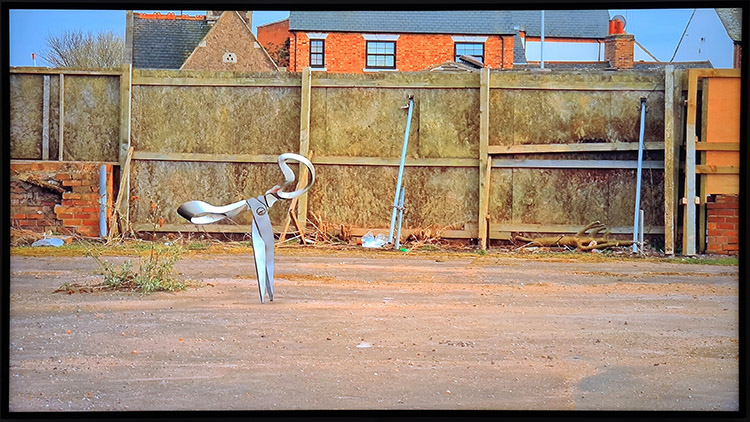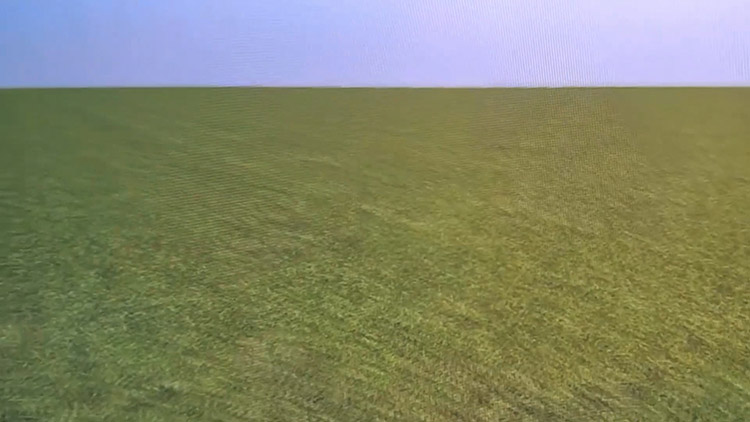Real Feelings
The exhibition Real Feelings - Emotions and Technology at the Haus der elektronischen Künste (HeK) in Basel brings together installations of around twenty artists. The idea: to reconsider the notion of feeling in this ‘technological’ society of the spectacle.

Ed Fornieles, Test Studies, 2017.
In the 20th century, the film industry largely monopolized the representation of human feelings, whereas in the 21st century, the video game industry engages our emotions through participation. At least that is what Ed Fornieles is trying to demonstrate with his video installation Test Studies in which three-dimensional simulations of a role-playing game are juxtaposed with the emotional comments of those who experience it. In 2017, the young woman speaking to the camera about one of the apocalyptic scenarios imagined by the British artist explains: "As the sick people started to pile up and the emergency hospitals couldn’t take it anymore, the panic started to set in. And as people started to get really sick and die, I think that was the point it hit home: Hey this is not just a normal kind of flue that is going to come and pass over”. Strangely premonitory. In 2020, when we are obliged to wear a mask at the rare artistic and cultural events that have not been cancelled, such as Art Basel, the player's words resonate differently in our minds. In this international pandemic that continues to frighten us, emotions about a simulated epidemic have become widespread.

Cécile B. Evans, How happy a Thing can be, 2014.
The three-dimensional aesthetics of video games can also be found in the film sequence How happy a Thing can be by Cécile B. Evans. Here, everyday objects - a pair of scissors, a comb and a screwdriver - are literally animated by emotions: the scissors’ dance in the middle of a wasteland is strikingly virtuosic. The strangeness of the situation inevitably summons up surrealist painting, although we can go back to the writings of Alphonse de Lamartine: "Inanimate objects, do you therefore have a soul attached to our soul and the strength to love?” Today, it is innovation companies that are trying to give life to the smallest of objects in our environment by connecting them to each other so that they can be given, at last, some ‘intelligence’, if not relative autonomy.

Maija Tammi, One of Them Is a Human, 2017.
Finnish artist Maija Maija Tammi the research laboratories of Japanese professor Hiroshi Ishiguro, whose anthropomorphic robots are well known. The result is a series of four photographs whose title, One of Them Is a Human, engages the public in detecting the human from the non-human. What is disturbing is that these are not computed images, but photographic snapshots. And it must be acknowledged that the distinction is difficult to make. A difficulty that is not likely to comfort us in our idea of our specificities in relation to robots. As the four faces are equally inexpressive, it is the lack of emotion in the human being surrounded by machines that is intriguing here. Fiction having accustomed us to consider the evolution of robots in our company, it is now time to consider the changes in our behaviour when we are surrounded by machines.

Troika, Terminal Beach, 2020.
The lack of emotion, from now on, would no longer be reserved for robots who excel in this matter to the point that they could take over from us when we are in the grip of remorse in our relentless pursuit of destroying the planet. This is the starting premise of the animated work Terminal Beach by the London collective Troika. When there is only one tree left on earth, an industrial robot so well trained by humans to cut trees, would try to cut it down. Note that the powerful robotic arm is clad in fur, evoking the human in its ancestral animality. When the despair of scientists is great, the cynicism of artists is absolute. Although the message of this disaster scenario is such as to encourage us to reconsider the possible consequences of our collective inaction.

Dani Ploeger, The Grass Smells So Sweet, 2018.
As the three curators of this exhibition, Sabine Himmelsbach, Ariane Koek and Angelique Spaninks, point out, "emotions are the core of human experience", but they only consider them through the filter of technology that contaminate them to the extreme. Dani Ploeger proposes an extreme experience with his virtual reality apparatus The Grass Smells So Sweet. At first glance, this is a conceptual work considering that the grass is no greener in his world than it is on the ground of his installation. At most, we are deprived of a body that we will have to part with one day. But suddenly something happens that the public could have anticipated on reading the testimonies collected by the artist. For they come from people who have survived being shot in the head. Which again brings us back to the cinema and video games, where this type of action inevitably triggers adrenaline rushes. All the creations in this exhibition invite us to consider emotions when they are in close proximity to the technology that either represent or control them.
Articles
- Art, technology and AI
- Immersive Art
- Chroniques Biennial
- 7th Elektra Biennial
- 60th Venice Biennial
- Endless Variations
- Multitude & Singularity
- Another perspective
- The Fusion of Possibilities
- Persistence & Exploration
- Image 3.0
- BioMedia
- 59th Venice Biennale
- Decision Making
- Intelligence in art
- Ars Electronica 2021
- Art & NFT
- Metamorphosis
- An atypical year
- Real Feelings
- Signal - Espace(s) Réciproque(s)
- On Combinations at Work
- Human Learning
- Attitudes and forms by women
- Ars Electronica 2019
- 58th Venice Biennale
- Art, Technology and Trends
- Art in Brussels
- Plurality Of Digital Practices
- The Chroniques Biennial
- Ars Electronica 2018
- Montreal BIAN 2018
- Art In The Age Of The Internet
- Art Brussels 2018
- At ZKM in Karlsruhe
- Lyon Biennale 2017
- Ars Electronica 2017
- Digital Media at Fresnoy
- Art Basel 2017
- 57th Venice Biennial
- Art Brussels 2017
- Ars Electronica, bits and atoms
- The BIAN Montreal: Automata
- Japan, art and innovation
- Electronic Superhighway
- Lyon Biennale 2015
- Ars Electronica 2015
- Art Basel 2015
- The WRO Biennale
- The 56th Venice Biennale
- TodaysArt, The Hague, 2014
- Ars Electronica 2014
- Basel - Digital in Art
- The BIAN Montreal: Physical/ity
- Berlin, festivals and galleries
- Unpainted Munich
- Lyon biennial and then
- Ars Electronica, Total Recall
- The 55th Venice Biennale
- The Elektra Festival of Montreal
- Digital practices of contemporary art
- Berlin, arts technologies and events
- Sound Art @ ZKM, MAC & 104
- Ars Electronica 2012
- Panorama, the fourteenth
- International Digital Arts Biennial
- ZKM, Transmediale, Ikeda and Bartholl
- The Gaîté Lyrique - a year already
- TodaysArt, Almost Cinema and STRP
- The Ars Electronica Festival in Linz
- 54th Venice Biennial
- Elektra, Montreal, 2011
- Pixelache, Helsinki, 2011
- Transmediale, Berlin, 2011
- The STRP festival of Eindhoven
- Ars Electronica repairs the world
- Festivals in the Île-de-France
- Trends in Art Today
- Emerging artistic practices
- The Angel of History
- The Lyon Biennial
- Ars Electronica, Human Nature
- The Venice Biennial
- Nemo & Co
- From Karlsruhe to Berlin
- Media Art in London
- Youniverse, the Seville Biennial
- Ars Electronica, a new cultural economy
- Social Networks and Sonic Practices
- Skin, Media and Interfaces
- Sparks, Pixels and Festivals
- Digital Art in Belgium
- Image Territories, The Fresnoy
- Ars Electronica, goodbye privacy
- Digital Art in Montreal
- C3, ZKM & V2
- Les arts médiatiques en Allemagne
- Grégory Chatonsky
- Le festival Arborescence 2006
- Sept ans d'Art Outsiders
- Le festival Ars Electronica 2006
- Le festival Sonar 2006
- La performance audiovisuelle
- Le festival Transmediale 2006
- Antoine Schmitt
- Eduardo Kac
- Captations et traitements temps réel
- Maurice Benayoun
- Japon, au pays des médias émergents
- Stéphane Maguet
- Les arts numériques à New York